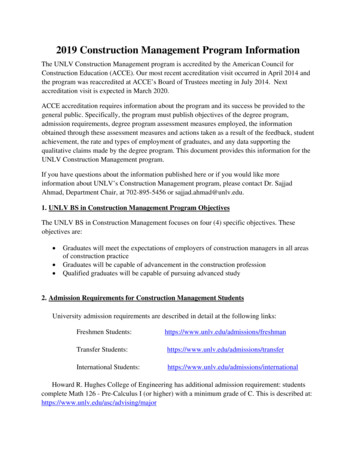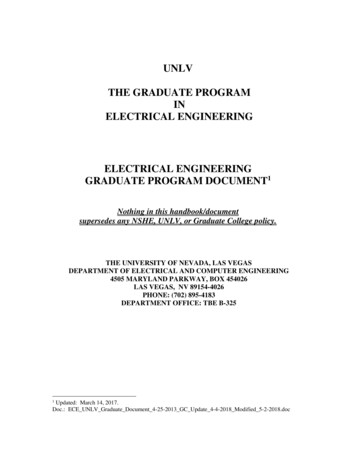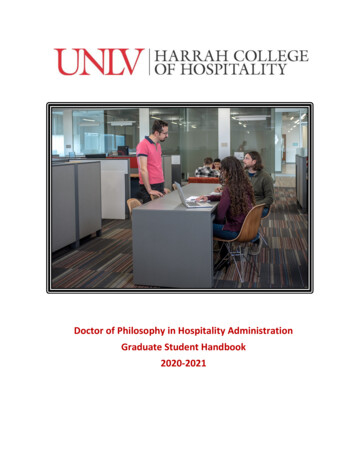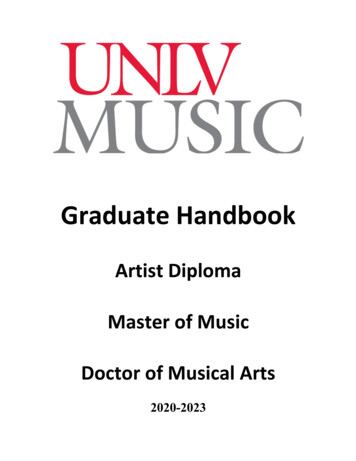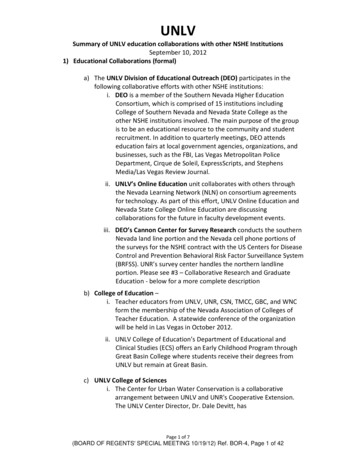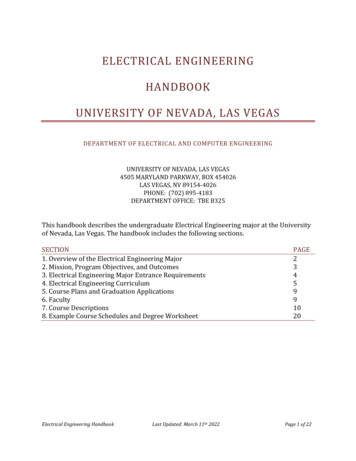
Transcription
ELECTRICAL ENGINEERINGHANDBOOKUNIVERSITY OF NEVADA, LAS VEGASDEPARTMENT OF ELECTRICAL AND COMPUTER ENGINEERINGUNIVERSITY OF NEVADA, LAS VEGAS4505 MARYLAND PARKWAY, BOX 454026LAS VEGAS, NV 89154-4026PHONE: (702) 895-4183DEPARTMENT OFFICE: TBE B325This handbook describes the undergraduate Electrical Engineering major at the Universityof Nevada, Las Vegas. The handbook includes the following sections.SECTION1. Overview of the Electrical Engineering Major2. Mission, Program Objectives, and Outcomes3. Electrical Engineering Major Entrance Requirements4. Electrical Engineering Curriculum5. Course Plans and Graduation Applications6. Faculty7. Course Descriptions8. Example Course Schedules and Degree WorksheetElectrical Engineering HandbookLast Updated: March 11th 2022PAGE2345991020Page 1 of 22
1. OVERVIEW OF THE ELECTRICAL ENGINEERING MAJORElectrical engineering is the application of scientific and mathematical principles tothe design, manufacture, and control of structures, machines, processes, and systems. Inthe past, the work of electrical engineers has had a direct and vital impact on people’s lives.Electrical engineers have been responsible for the creation of electric power, modernelectronics, computers, electronic communication systems, modern flight controllers,automated manufacturing, and medical diagnostic tools. An electrical engineeringeducation continues to provide opportunities for solving problems of great socialsignificance and for increasing people’s quality of life.The electrical engineering program, accredited by the Engineering AccreditationCommission of ABET (Accreditation Board for Engineering and Technology, Inc.)http://www.abet.org, spans the disciplines of electronics, computers, circuits,electromagnetic fields, power systems, controls, communications, signal processing, andsolid state materials and devices. The degree requires a minimum of 121 credit hourswhich include at least 27 credit hours from UNLV's General Education Core. Graduates ofthe program will receive a Bachelor of Science in Engineering with a Major in ElectricalEngineering.The Department also offers a major in Computer Engineering. For furtherinformation about that major, a separate handbook is available on the Electrical andComputer Engineering Department website.Electrical Engineering HandbookLast Updated: March 11th 2022Page 2 of 22
2. MISSION, PROGRAM OBJECTIVES, AND OUTCOMES2.1 THE MISSION OF THE DEPARTMENT OF ELECTRICAL AND COMPUTER ENGINEERINGThe mission of the Department of Electrical and Computer Engineering is to serve society as acenter of higher learning by providing an electrical and computer engineering education to society’sfuture leaders, innovators, and engineers.Goals1.2.3.4.Provide undergraduate, graduate, and professional education.Create knowledge through research.Disseminate knowledge through publication.Provide private and public service, in as much as said service educates, creates anddisseminates knowledge, or functions as a repository of knowledge.2.2 ELECTRICAL ENGINEERING PROGRAM EDUCATIONAL OBJECTIVESThe Program Educational Objective of the Electrical Engineering program is to create, apply, anddisseminate knowledge immediately or within a few years after graduation the graduate1. Can successfully practice and mature intellectually in the field of Electrical Engineering or arelated field.2. Can be admitted to and successfully progress through a post graduate program in ElectricalEngineering or related program.2.3 ELECTRICAL ENGINEERING STUDENT OUTCOMESTo achieve these objectives and goals, each graduate of the Electrical Engineering Major will attainthe following outcomes before graduation:1. An ability to identify, formulate, and solve complex engineering problems by applyingprinciples of engineering, science, and mathematics.2. An ability to apply engineering design to produce solutions that meet specified needs withconsideration of public health, safety, and welfare, as well as global, cultural, social,environmental, and economic factors.3. An ability to communicate effectively with a range of audiences.4. An ability to recognize ethical and professional responsibilities in engineering situationsand make informed judgments, which must consider the impact of engineering solutions inglobal, economic, environmental, and societal contexts.5. An ability to function effectively on a team whose members together provide leadership,create a collaborative and inclusive environment, establish goals, plan tasks, and meetobjectives.6. An ability to develop and conduct appropriate experimentation, analyze and interpret data,and use engineering judgment to draw conclusions.7. An ability to acquire and apply new knowledge as needed, using appropriate learningstrategies.Electrical Engineering HandbookLast Updated: March 11th 2022Page 3 of 22
3. ELECTRICAL ENGINEERING MAJOR ENTRANCE REQUIREMENTSTo enter the Electrical Engineering (EE) Major, a student must be admitted to the College ofEngineering. Students who have been admitted to the College of Engineering and are interested inbeing admitted to the EE Major will be placed in the Electrical Engineering Pre-major (EEPRE). Astudent in the EEPRE is eligible to submit an application to the Engineering Advising Center foradvanced standing in the EE Major after completing 18 credits of the 46-credit EEPRE curriculumlisted below. Students who have not completed the EEPRE curriculum and do not have advancedstanding in the EE Major cannot enroll in upper division Electrical Engineering courses except forthose listed below in the EEPRE Extended Curriculum.ELECTRICAL ENGINEERING PRE-MAJOR (EEPRE) CURRICULUMSciences (4 credits) PHYS 180Physics for Scientists and Engineers I PHYS 180LPhysics for Scientists and Engineers Lab IMathematics (8 Credits) Math 181Calculus I Math 182Calculus IIElectrical and Computer Engineering (3 credits) CpE 100Digital Logic Design IComputer Science (3 credits) CS 135 Computer Science IELECTRICAL ENGINEERING PRE-MAJOR (EEPRE) EXTENDED CURRICULUMSciences (4 credits) PHYS 181Physics for Scientists and Engineers II PHYS 181LPhysics for Scientists and Engineers Lab IIMathematics (10 Credits) MATH 283Calculus III MATH 431Mathematics for Engineers and Scientists I MATH 432Mathematics for Engineers and Scientists IIElectrical and Computer Engineering (14 credits) CpE 200Digital Logic Design II CpE 200LDigital Logic Design II Laboratory CpE 300Digital System Architecture and Design EE 220Circuits I EE 220DCircuits I Discussion EE 221Circuits II EE 221LCircuits II LaboratoryElectrical Engineering HandbookLast Updated: March 11th 2022Page 4 of 22
4. ELECTRICAL ENGINEERING CURRICULUMThe undergraduate Electrical Engineering major requires the completion of courses in the followingareas, which are described in the remainder of this section. General Education Core:Math, Computer Science, and Natural Science:Fundamental Courses:Core Courses:Labs:Professional Electives:Math/Science creditscreditscreditscreditscreditscredits4.1 REQUIRED UNLV GENERAL EDUCATION CORE COURSES (27-30 CREDITS)English Composition (6 credits) ENG 101Composition & Rhetoric I ENG 102Composition & Rhetoric IISeminars (2-3 credits) EGG 101Introductory Engineering Experience (1 - 2 Credits) EGG 202Second Year Hands-on Design Experiences in Engineering and ComputerScience (1 Credit)Constitutions (4-6 credits) HIST 100Historical Issues and Contemporary Man PSC 101Introduction to American Politics (OR) a combination of one course from each of the following two listso US Constitution HIST 101 United States: Colonial Period to 1865 HIST 106 European Civilization Since 1648o Nevada Constitution HIST 102 United States: 1865 to Present HIST 217 Nevada History PSC 100 Nevada ConstitutionSocial Science (6 credits) EGG 307Engineering Economics See the Faculty Senate General Education web-page for courses that satisfy thisrequirement. (Not ECON)Humanities (6 credits) PHIL 242Ethics For Engineers and Scientists (counted towards Ethics) COM 216Survey of Communication StudiesFine Arts (3 credits) See the Faculty Senate General Education website for courses that satisfy this requirement.Electrical Engineering HandbookLast Updated: March 11th 2022Page 5 of 22
Mathematics - Credits: (Fulfilled by Major Requirements) MATH 181 - Calculus IMulticultural and International Requirements (overlap) Multicultural requirement (3 credits) International requirement (3 credits)The multicultural and international requirements can simultaneously fulfill other general educationcore requirements; however, a single course cannot meet the multicultural and internationalrequirements simultaneously. To determine courses satisfying these requirements, consult theFaculty Senate General Education Committee.4.2 REQUIRED MATHEMATICS, COMPUTER SCIENCE, AND NATURAL SCIENCE COURSES(29 CREDITS)CS 135MATH 181MATH 182MATH 283MATH 431MATH 432or MATH 459PHYS 180PHYS 180LPHYS 181PHYS 181LComputer Science ICalculus I (also counted as UNLV General Education Core Requirements)Calculus IICalculus IIIMathematics for Engineers and Scientists IMathematics for Engineers and Scientists IIElementary Complex AnalysisEngineering Physics IEngineering Physics I LaboratoryEngineering Physics IIEngineering Physics II Laboratory4.3 REQUIRED ELECTRICAL ENGINEERING FUNDAMENTAL COURSES (33 CREDITS)Each student must complete the following courses:CpE 100CpE 200/DCpE 200LEE 220/DEE 221EE 221LEE 320EE 320LEE 330/DEE 360EE 361EE 370EE 497EE 498Digital Logic Design IDigital Logic Design II Discussion (must be taken or re-taken together)Digital Logic Design II LaboratoryCircuits I Discussion (must be taken or re-taken together)Circuits IICircuits II LaboratoryElectronics IElectronics I LaboratoryEngineering Electromagnetics Discussion (must be taken or re-taken together)Signals and Systems I DiscussionSignals and Systems IIControl Systems ( or ME 421 - Automatic Controls)Senior Design Project ISenior Design Project IIElectrical Engineering HandbookLast Updated: March 11th 2022Page 6 of 22
4.4 REQUIRED ELECTRICAL ENGINEERING CORE COURSES (15 CREDITS)Each student must complete at least one course in six out of the eight core areas below:Computers CpE 300 CpE 301 CpE 302Digital System Architecture and DesignEmbedded Systems DesignSynthesis and Verification using Programmable DevicesElectronics EE 420 EE 421Electronics IIDigital ElectronicsElectromagnetism EE 430 EE 431 EE 432 EE 436Transmission LinesEngineering OpticsAntenna EngineeringActive and Passive Microwave EngineeringQuantum Optics EE 310Principles of Solid State and Optoelectronic SystemsPower EE 340Power System EngineeringSolid State EE 450Solid State DevicesCommunications EE 460Analog and Digital CommunicationsControls EE 472Digital Control SystemsDigital Signal Processing EE 480Digital Signal Processing4.5 REQUIRED ELECTRICAL ENGINEERING LABORATORY COURSES (4 CREDITS)Each student must complete at least five laboratory courses from the following list:CpE 300LCpE 310LEE 340LEE 370LEE 420LEE 421LEE 450LEE 460LEE 480LDigital Systems Architecture and Design LaboratoryEmbedded Systems Design Laboratory for EEPower System Engineering LaboratoryControl System LaboratoryEngineering Electronics II LaboratoryDigital Integrated Circuit Design LaboratorySolid State Characterization LaboratoryCommunication Systems LabDigital Signal Processing LaboratoryElectrical Engineering HandbookLast Updated: March 11th 2022Page 7 of 22
4.6 REQUIRED ELECTRICAL ENGINEERING PROFESSIONAL ELECTIVE COURSES(9 CREDITS)Each student must complete 9 credits of approved professional electives that are listed in Table 1.Of the 9 credits, six of the credits must be EE or CpE courses. Students are encouraged to selectsequences within a particular core field. The other three credits must be mathematics or sciencecourses (BIOL, CHEM, MATH, PHYS, STAT). Students who want to apply a professional elective thatis not listed in Table 1 towards their EE degree must obtain the Department Chair’s and theUndergraduate Curriculum Committee Chair’s approval.Table 1: Professional Electives for Electrical EngineeringUnless also listed below, the prerequisites for these courses do not qualify as professional electives.CpE 400CpE 403CpE 404CpE 405CpE 407CpE 408CpE 409CpE 476CpE 477EE 310EE 330EE 340EE 370EE 420EE 421EE 430EE 431EE 432EE 436EE 442EE 446EE 450EE 451EE 452EE 453EE 460EE 462Computer Communications NetworkAdvanced Embedded SystemsModern Processor ArchitectureInformation Coding SystemsBiometrics and Machine LearningVLSI Physical Design and TestingEmbedded DSPMobile RoboticsEmbedded Security and MachineLearningPrinciples of Solid State andOptoelectronic SystemsEngineering ElectromagneticsPower System EngineeringControl SystemElectronics IIDigital Integrated Circuit DesignTransmission LinesEngineering OpticsAntenna EngineeringActive and Passive Microwave Eng.Power ElectronicsPhotovoltaic Devices and SystemsSolid State DevicesElectronic & Mag. Materials & Devic.Intro to Optical ElectronicsIntroduction to NanotechnologyAnalog and Digital CommunicationAdvanced Digital CommunicationEE 466EE 472EE 480EE 482Wireless and Mobile Comm.Digital Control SystemsDigital Signal ProcessingIntro to Biomedical Signals andSystemsEE 493Independent StudyEE 495Special TopicsCHEM 121 Chemistry ICHEM 121L Chemistry I LaboratoryCHEM 122A General Chemistry IIMATH 271 Elementary ProbabilityMATH 283 Calculus IIIMATH 330 Linear AlgebraMATH 432 Mathematics for Engineers &Scientists IIMATH 451 Foundations of Mathematics IMATH 468 Applied Finite Element AnalysisPHYS 182Physics for Scientists & Engineers IIIPHYS 250Special RelativityPHYS 411Modern Physics IPHYS 461Light and Physical OpticsPHYS 462Modern OpticsPHYS 483Special Topics in PhysicsSTAT 467Intro. to Mathematical StatisticsSTAT 493Applied Regression AnalysisSTAT 495Nonparametric StatisticsMGT 497Business Plan CreationEGG 460Technology Commercialization4.7 REQUIRED MATH / SCIENCE ELECTIVE COURSE (4 CREDITS)All majors must also take an elective math (MATH or STAT) or science (BIOL, CHEM, or PHYS)course.4.8 GRADE REQUIREMENTSAll EE, CpE, ME, CS, BIOL, CHEM, MATH, PHYS, and STAT courses must be completed with a grade ofC or better.Electrical Engineering HandbookLast Updated: March 11th 2022Page 8 of 22
4.9 MISCELLANEOUS REQUIREMENTSEach student must also meet all College of Engineering requirements including those relating tocollege suspension and readmission. The Department can refuse to accept any course taken morethan eight years prior to graduation.5. COURSE PLANS AND GRADUATION APPLICATIONSEvery student must consult an advisor in the Engineering Advising Center every semester beforeregistering and make or update a Degree Worksheet. One year before graduation the studentshould submit a Graduation application. The example schedules and degree worksheet located atthe end of this handbook are provided to help guide students while planning their class schedules.Electrical engineering students should expect to study about 2 to 3 hours per week outside class foreach credit. For example, a student taking 16 credit hours should expect to spend 32 to 48 hourseach week studying outside of class. Combined with time in class, this works out to a total of 48 to64 hours spent on academic work. Students who are working while attending school should adjusttheir academic load accordingly. The following serves as an overall guideline.Academic LoadFall or SpringSummer16 credits12 credits8 credits3 credits6 credits3 creditsExpected Study TimeMaximum Non-Academic Workload32 to 48 hours / week24 to 32 hours / week16 to 24 hours / week6 to 9 hours / week0 to 8 hours / week8 to 16 hours / week16 to 22 hours / week32 to 40 hours / week6. FACULTYThe faculty of the Department of Electrical and Computer Engineering are:Yahia BaghzouzJacob BakerBiswajit Das, ChairSarah Harris, Undergraduate CoordinatorYingtao JiangPushkin KachrooShahram LatifiBrendan MorrisVenkatesan MuthukumarWilliam L. Brogan (Emeritus)Ramon Martinez (Emeritus)Electrical Engineering HandbookEmma RegentovaEbrahim SaberiniaRobert Schill, Jr.Henry SelvarajSahjendra SinghPeter StubberudKe-Xun (Kevin) SunRama VenkatMei Yang, Graduate CoordinatorEugene McGaugh, Jr.(Emeritus)John Tryon (Emeritus)Last Updated: March 11th 2022Page 9 of 22
7. COURSE DESCRIPTIONS IN ELECTRICAL ENGINEERINGELECTRICAL ENGINEERINGAll prerequisites must be completed with a grade of C or higher.EGG 101 - Introduction to Engineering ExperienceSeminar: Introduction to UNLV learning outcomes and the programs that reside within the Collegeof Engineering. Topics include professional ethics, technical communication, the design process,and technology’s impact on a global society. 1-2 Credits.Prerequisites: For undergraduate degree-seeking students only.Notes: Combination of EGG 101 and EGG 202 satisfies First Year Seminar requirement.EGG 202 - Second Year Hands-on Design Experiences in Engineering and ComputerScienceA holistic experience for second-year engineering and computer science students. Lab work,improve study skills, strengthen/solidify their sense of community, career paths exploration,update of their academic plan. 1 Credits.Prerequisites: Sophomore standing and EGG 101.Notes: Combination of EGG 101 and EGG 202 satisfies First Year Seminar requirement.EE 220 Circuits IIntroduction to linear circuit analysis. Kirchhoff’s laws, operational amplifiers, node and loopanalysis. Thevenin, Norton, and other network theorems, first order RL and RC circuits, secondorder RLC circuits. 3 creditsCorequisite: EE 220D; Prerequisite: MATH 182EE 220D Circuits I DiscussionIntroduction to PSpice simulation tool for electrical circuits, problem solving using SPICE. 0 creditsCorequisite: EE 220EE 221 Circuits IISinusoidal steady state analysis using phasors, sinusoidal steady state power, three-phase circuits,the Laplace transform and its application to circuit analysis, transfer functions, frequency response,magnetically coupled circuits and transformers, two-port networks. 3 creditsPrerequisites: EE 220 and (CS 117 or CS 135)EE 221L Circuits II LaboratoryBasic measurements and instrumentation. Principles of experimentation. 1 creditCorequisite: EE 221EE 292 Fundamentals of Electrical and Computer EngineeringIntroduction to electric circuit analysis, electronic devices and circuits, transducers, electricmachines, and power transmission. For non-electrical engineering majors only. 3 creditsPrerequisites: MATH 182 and (PHYS 180 or PHYS 151)EE 310 - Principles of Solid State and Optoelectronic SystemsModern experiments, concepts, and theory important for study in photonics, optoelectronics, solidstate devices, and nanotechnology. Topics: electrons and photons, counting and interferenceexperiments, optical resonator, Schrodinger equation, quantum dots, atoms, molecules, solids,Fermi-Dirac distribution, Bose-Einstein distribution, energy bands, photonic crystals. 3 CreditsPrerequisites: PHYS 181 with a minimum grade of C or better.Electrical Engineering HandbookLast Updated: March 11th 2022Page 10 of 22
EE 320 Engineering Electronics ICircuit design and analysis using diodes and transistors. Introduction to semiconductor physics.Circuit simulation with SPICE. 3 creditsPrerequisites: CHEM 121, EE 221, PHYS 181, PHYS 181L, and (MATH 431 or CpE 260)EE 320L Engineering Electronics I LaboratoryLaboratory-based analysis and design of electrical and electronic systems. 1 creditCorequisite: EE 320; Prerequisites: CHEM 121, EE 221, MATH 431 or CpE 260, PHYS 181, andPHYS 181LEE 330 Engineering ElectromagneticsStatic electric and magnetic fields. Dielectric and ferromagnetic materials. Laplace's equation. Timevarying electric and magnetic fields. Maxwell's equations. Plane waves in various mediums. Normalincidence. Engineering applications. 3 creditsCorequisite: MATH 432 and EE 330D; Prerequisites: EE 221, PHYS 181, and MATH 431EE 330D Engineering Electromagnetics DiscussionThis discussion class reinforces electromagnetic theory and problem solving by applying the lawsof nature in a vector calculus manner. 0 creditsCorequisite: EE 330EE 340 Power System EngineeringElectric energy sources and energy conversion principles, modeling and analysis of synchronousgenerators, transmission lines, transformers, AC and DC machines, brief introduction to powersystem analysis including power flow, fault calculation and economic dispatch. 3 creditsCorequisite: EE 330; Prerequisite: EE 320EE 340L Power System Engineering LaboratoriesMeasurement of different electric powers, measurement of equivalent circuit parameters andcharacteristics of electric generators, transformers, transmission lines, AC and DC motors, use ofsoftware packages for fault calculation and load flow. 1 creditCorequisite: EE 340; Prerequisite: EE 320LEE 360 Signals and Systems IDeterministic signals and linear systems. Time domain description and analysis of analog anddiscrete linear systems. Analysis of linear systems using the Laplace transform and the z-transform.Block diagram and flow graph representation of signals and linear systems. Introduction to statespace representation and analysis. 3 creditsCorequisite: EE 360D and (MATH 432 or MATH 459); Prerequisites: (EE 221 or EE 292) and(MATH 431 or CpE 260)EE 360D Signals and Systems I DiscussionProgramming methods in signals and systems. Topics include generating signals, implementingsystems including direct form and state space implementations, determining zero input and zerostate responses of linear systems, plotting linear system frequency responses and generating polezero plots from system functions. 0 creditsCorequisite: EE 360; Prerequisites: (EE 221 or EE 292) and (MATH 431 or CpE 260)Electrical Engineering HandbookLast Updated: March 11th 2022Page 11 of 22
EE 361 Signals and Systems IIStochastic and deterministic signals and linear systems. Analog and discrete Fourier series, analogand discrete Fourier transforms, basic probability theory, stochastic processes, stochastic signals,and linear systems. 3 creditsPrerequisites: EE 360 and (MATH 432 or MATH 459)EE 370 Classical Feedback and Control SystemsIntroduction to control systems. Feedback control characteristics, performance, stability. Analysis,synthesis, and design of feedback control systems including digital techniques. 3 creditsPrerequisites: EE 360 and (MATH 459 or MATH 432)EE 370L Classical Feedback and Control Systems LaboratoryIntroduction to using MATLAB to model/simulate control systems, feedback control characteristics,performance, stability, analysis, synthesis and design of feedback control systems including digitaltechniques. 1 creditCorequisite: EE 370; Prerequisites: EE 360 and (MATH 459 or MATH 432)EE 414 Quantum CommunicationReview of quantum mechanics and wave optics. Quantum harmonic oscillators. Field quantization.Single mode, two mode, and multi-mode quantum optics. Quantum information. Semiclassical andquantum photo-detection. Fiber optics and free space communication channels. Quantum keydistribution. 3 creditsPrerequisites: EE 310EE 416 Space Sensors and InstrumentsAstrophysical and space science concepts. Space environments. Spacecraft orbits. Spacecraftsensors for electromagnetic waves, photons, and particle radiation. Radiometry. Interferometry.Telescope design. Arrayed sensors. Remote sensing. CubeSats. Constellation flight. Case study ofspacecraft, payload, and mission design. May involve hands-on projects. 3 creditsPrerequisites: EE 310EE 420 Engineering Electronics IIAn introduction to the design, layout, and simulation of analog integrated circuits including currentmirrors, voltage and current references, amplifiers, and op-amps. 3 creditsPrerequisites: EE 320EE 420L Electronics II LaboratoryApplications and study of modern electronic analog and digital circuits. Advanced instrumentation.1 creditCorequisite: EE 420; Prerequisite: EE 320LEE 421 Digital Integrated Circuit DesignAn introduction to the design, layout, and simulation of digital integrated circuits. MOSFEToperation and parasitics. Digital design fundamentals including the design of digital logic blocks. 3creditsPrerequisites: CpE 100 and EE 320EE 421L Digital Integrated Circuit Design LaboratoryDigital circuit analysis. Discrete and integrated circuit technology, logic families, A/D-D/A circuits,comparators, Schmitt triggers. 1 creditCorequisite: EE 421; Prerequisite: EE 320LElectrical Engineering HandbookLast Updated: March 11th 2022Page 12 of 22
EE 430 Transmission LinesTelegraphist’s equation; transient response, steady state response; reflection diagrams; Smithchart; matching techniques and designs; narrow and broadband impedance; scattering matrix;introduction to stripline and microstrip devices. 3 creditsPrerequisite: EE 330EE 431 Engineering OpticsEngineering applications of optics. Includes aperture and grating antennas, holography, opticalimage processing, optical waveguides, and tomography. 3 creditsPrerequisites: EE 330 and (MATH 432 or MATH 459)EE 432 Antenna EngineeringFundamentals of antennas and antenna design; linear wire, loop and antenna arrays. Antennameasurements. 3 creditsPrerequisites: EE 330 and (MATH 432 or MATH 459)EE 436 Active and Passive Microwave EngineeringWaveguides, dispersion diagrams, microwave network analysis, broadband impedance matching,open and closed resonators, power dividers, directional couplers, filters, circulators, phase shifters,introduction to solid state amplifier or oscillator design. 3 creditsPrerequisites: EE 330 and (MATH 432 or MATH 459)EE 438 Radar in IndustryFundamentals of radar including industry applications such as mapping, imaging and electronicwarfare.Prerequisites: EE 320 or equivalent or consent of instructor.EE 442 Power ElectronicsTopics include: Diode circuits and rectifiers, power semiconductor diodes and transistors,thyristors and static switches, controlled rectifiers, AC voltage controllers, DC choppers, inverters,AC and DC drives, power supplies, protection of devices and circuits. 3 creditsPrerequisites: EE 320 and EE 340EE 446 – Photovoltaic Devices and SystemsSolar resource characteristics, solar cell physics and technologies, cell electrical characteristics, PVmodule design, DC-AC inverters, battery energy storage and charge controllers, design of standalone and grid-connected PV Systems, economic considerations. 3 creditsPrerequisites: MATH 182 or consent of instructor.EE 450 Solid State DevicesSemiconductor physics, pn diode, bipolar junction transistor, metal semiconductor FET devices,metal oxide semiconductor FET devices. 3 creditsPrerequisites: EE 320 and MATH 431EE 450L Solid State Characterization LaboratoryCapacitance and voltage, Hall mobility and carrier concentration, oxidation and etching silicondioxide processing of silicon. 1 creditPrerequisite: EE 450Electrical Engineering HandbookLast Updated: March 11th 2022Page 13 of 22
EE 451 Electronic and Magnetic Materials and DevicesSemiconductors, dielectrics, ferroelectrics, antiferromagnetics, ferromagnetics, ferrimagnetics,crystal structure, structure-property relations, device applications. 3 creditsPrerequisite: EE 330EE 452 Introduction to Optical ElectronicsTopics include: modulation of light, display devices, lasers, photodetectors, fiber optics, engineeringapplications, and systems. 3 creditsPrerequisite: EE 330EE 453 Introduction to NanotechnologyOverview of Nanotechnology, Physics of the Solid State, Properties of Individual Nanostructures,Bulk Nanostructured materials, magnetic nanoparticles, Quantum Wells, Wires and Dots, SelfAssembly and Catalysis, nanoscale Biological materials. 3 creditsPrerequisite: EE 320EE 460 Analog and Digital CommunicationsAn introduction to analog and digital communication systems. Communication channels,modulation and demodulation, DSB, AM, SSB, FM and PM modulation schemes. Analog to digitalconversation, sampling theorem, quantization noise and PCM systems. Line coding and digitalcarrier modulation schemes including ASK, PSK, FSK and QAM. 3 creditsPrerequisite: EE 361EE 460L Communication Systems LaboratoryAn introduction to analog and digital communication systems. Communication channels,modulation and demodulation, DSB, AM, SSB, FM and PM modulation schemes. Analog to digitalconversation, sampling theorem, quantization noise and PCM systems. Line coding and digitalcarrier modulation schemes including ASK, PSK, FSK and QAM. 1 creditCorequisite: EE 360EE 462 Advanced Digital CommunicationsFundamentals of digital communication systems including Line Coding, ASK, PSK, FSK and QAMmodulations, receiver design and performance evaluation, band-limited channels. 3 creditsPrerequisite: EE 460EE 466 Wireless and Mobile CommunicationThe study of wireless systems including cellular telephone systems, wireless local area networksand other wireless data services. Topics include digital modulation techniques, frequency reuse,diversity techniques, multiple access schemes and channel modeling including path loss,shadowing, fading and multipath interference. 3 creditsPrerequisites: EE 460EE 472 Digital Control SystemsIntroduction to discrete time of control. State space representation of linear systems; stability; theconcepts of controllability and observability. Sample data control system design techniques,including pole placement, observer design. 3 creditsPrerequisite: EE 370Electrical Engineering HandbookLast Updated: March 11th 2022Page 14 of 22
EE 480 Digital Signal ProcessingReview of discrete linear system theory including the z-transform, the Fourier transform, discreteand fast Fourier transform. Sampling, reconstruction and multirate systems, IIR and FIR digitalfilter design including digital filter structures and finite word length effects. 3 creditsPrerequisite: EE 361EE 480L Digital Signal Processing LaboratoryLaboratory projects and exercises in di
Electrical Engineering Handbook Last Updated: March 11 th 2022 Page 2 of 22 1. OVERVIEW OF THE ELECTRICAL ENGINEERING MAJOR Electrical engineering is the application of scientific and mathematical principles to the design, manufacture, and control of structures, machines, processes, and systems. In
